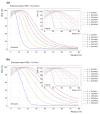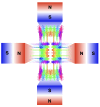Very High-Energy Electron Therapy Toward Clinical Implementation
- PMID: 39857964
- PMCID: PMC11763822
- DOI: 10.3390/cancers17020181
Very High-Energy Electron Therapy Toward Clinical Implementation
Abstract
The use of very high energy electron (VHEE) beams, with energies between 50 and 400 MeV, has drawn considerable interest in radiotherapy due to their deep tissue penetration, sharp beam edges, and low sensitivity to tissue density. VHEE beams can be precisely steered with magnetic components, positioning VHEE therapy as a cost-effective option between photon and proton therapies. However, the clinical implementation of VHEE therapy (VHEET) requires advances in several areas: developing compact, stable, and efficient accelerators; creating sophisticated treatment planning software; and establishing clinically validated protocols. In addition, the perspective of VHEE to access ultra-high dose-rate regime presents a promising avenue for the practical integration of FLASH radiotherapy of deep tumors and metastases with VHEET (FLASH-VHEET), enhancing normal tissue sparing while maintaining the inherent dosimetric advantages of VHEET. However, FLASH-VHEET systems require validation of time-dependent dose parameters, thus introducing additional technological challenges. Here, we discuss recent progress in VHEET research, focusing on both conventional and FLASH modalities, and covering key aspects including dosimetric properties, radioprotection, accelerator technology, beam focusing, radiobiological effects, and clinical outcomes. Furthermore, we comprehensively analyze initial VHEET in silico studies on coverage across various tumor sites.
Keywords: FLASH radiotherapy; VHEE; external beam radiotherapy.
Conflict of interest statement
The authors declare no conflicts of interest.
Figures









References
-
- Gahbauer R., Landberg T., Chavaudra J., Dobbs J., Gupta N., Hanks G., Horiot J.-C., Johansson K.-A., Möller T., Naudy S., et al. Prescribing, Recording, and Reporting Electron Beam Therapy. J. ICRU. 2004;4:5–9. doi: 10.1093/jicru/ndh001. - DOI
Publication types
Grants and funding
- CUP B53C22001750006, ID D2B8D520, IR0000016/NextGeneration EU Integrated Infrastructure Initiative in Photonic and Quantum Sciences - I-PHOQS
- ECS_00000017, D.D. MUR No. 1055 23 May 2022/Tuscany Health Ecosystem - "THE" Spoke 1 - Advanced Radiotherapies and Diagnostics in Oncology, NextGenerationEU
- CUP I93C21000160006, IR0000030/EuPRAXIA Advanced Photon Sources - EuAPS
- No. 101079773/Program EuPRAXIA Preparatory Phase
LinkOut - more resources
Full Text Sources

